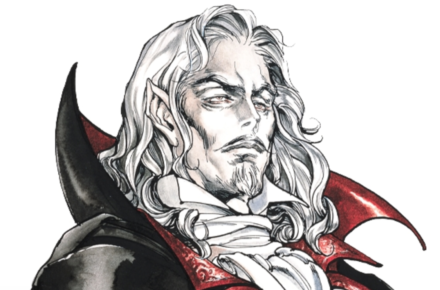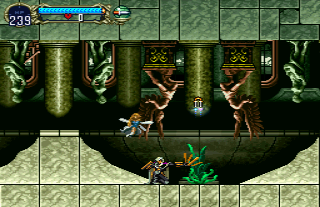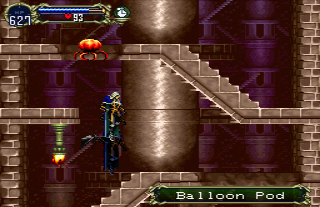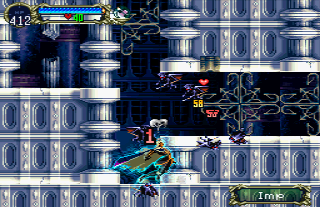The Complexities of Castlevania: SOTN – Developing Game Challenges
December 22nd, 2017
[When developing Castlevania: Symphony of the Night, director Koji Igarashi wanted to make a game which would “overturn player’s ideas about Castlevania, yet also feel like a Castlevania game”. In pursuing this vision, his team made SOTN’s game system much more complex, incorporating RPG systems and a wide variety of nuanced player actions. This series of articles will examine how these additions shape SOTN’s core gameplay of moving through space to dodge and attack enemies.]
To conclude the series, I want to discuss a handful of game challenges which demonstrate how SOTN’s designers leveraged the game’s various systems and complexities to create the moment-to-moment gameplay. The examples generally fall into one of two categories: challenges which utilise the core dynamics of space, time, and gravity and challenges which test the player’s knowledge of SOTN’s nuanced complexities. By looking at these examples, we can make sense of how SOTN’s game systems work in context.
Bone Pillar and Morning Star Trap on Stairs
This example is one of the few challenges that leverages gravity to great effect. At this point in the game, Alucard shouldn’t yet have the double jump or high jump, so the player cannot jump over the arrangement of game elements. The Bone Pillar’s fire breath shoots out at set intervals, so the challenge is orientated around timing. However, by defeating the Bone Pillar, Alucard releases the morning star which subsequently rolls down the staircase. So defeating one challenge organically facilitates another. Alucard’s lower position on the staircase limits his options for escape. (He should probably jump to the left and then swing back to the right, which is hard to do with limited hang time). The designers leverage height and gravity to create a lock and increase challenge.
Blood Skeleton Mosh Pit
Blood Skeletons (enemies that walk back and forth, and rebuild themselves after taking damage; think Dry Bones from the Mario games) swamp the shallow pit. The low ceiling and raised ledge sandwich Alucard and make it difficult for him to enter the crowded space. These limitations encourage more creative solutions. I came up with two: running through as Wolf Alucard and air kicking my way across, allowing the mosh pit to carry Alucard.
Corpseweed in a Dome Pit
A series of curved pits draw the player towards the centre where a corpseweed lies. The slowing effect of the bowl, the crouching height of the weed, and the flat space in the centre for the player to crouch attack together converge to shorten the time the player has to stop the weed from sprouting into a giant plant. Air-kicking the leafy mass allows the player to traverse this area quickly as the diagonal-downwards trajectory avoids the slowing effect of crossing the curves of the dome and allows the player to rebound and jump into the next dome, setting up the subsequent attack.
A Tight Squeeze Past Balloon Pod
Balloon Pods fill the gaps that lead up the shaft. If Alucard attacks or touches a Balloon Pod, it will burst open, unleashing a spray of spores. Since the spores fill the gap and take several seconds to vanish, the arrangement encourages the player to carefully squeeze past the obstacles, with dexterity being a required skill.
Imp Swarm
In this long, narrow shaft, a steady stream of Imps spawn. These pests track Alucard and interrupt his ascent by knocking him back to the ground. The longer the player spends recovering from knock backs, the more Imps spawn in, and the harder it is to avoid the swarm. Furthermore, the floating devils sometimes petrify Alucard or curse him to stand on the spot and attack, allowing even more of their pitchfork-wielding friends to swoop on in. The column constricts the space around Alucard and by extension the player’s movement options, while the pit (pictured) acts as a choke point, trapping Alucard within. The arrangement of game elements leverage two nuances (Alucard’s knockback and the Imp’s petrify and curse attacks) to create a unique “race against time” themed challenge.
Galamoth Boss Fight
Interviewer: Who do you think is the toughest enemy in Symphony of the Night?
Hagihara: Under normal conditions, Galamoth is a tough fight. If you don’t have any extra power from equipment it’s a real slog.
Igarashi: We made him so that if you just tried to fight him normally, you couldn’t win. I mean, that’s the kind of character he originally was. (laughs) Please enjoy him as one of the post-game challenges.
Hagihara: The truth is Galamoth was supposed to be far stronger than Shaft or Dracula..
The developers intentionally inflated Galamoth’s difficulty so as to encourage players to find creative ways of defeating the monster. In this case, taking advantage of the complexities and nuances of SOTN’s combat system. The video below highlights the excessive extremities of SOTN’s abstract subsystems.
http://www.youtube.com/watch?v=X72uf-HcZmA
Shield Rod + Alucard Shield – This technique requires that the player exploit a hidden property of the Shield Rod. According to the Castlevania Wiki, when the player equips a Shield Rod and Alucard Shield, the Alucard Shield has:
“the ability to deal a base 255 Hit damage multiple times per second when in contact with the enemy. The shield also recovers 8 HP, 1 Heart, and grants 3 seconds of invincibility, although MP is drained continuously when in use”.
The Shield Rod’s text description (“Extra Effective With Shield”) appears to be the only clue the game provides. Even after following the hint, a significant degree of trial and error would be needed to unearth the combination and its effective application against Galamoth.
Use the Duplicator to Spam Healing Items and Expendable Weapons – Post-game pick-up the Duplicator allows Alucard to hold an endless supply of items. So when facing Galamoth, the player can spam healing potions to minimise any damage taken. Then when they have a moment to breathe, they can shower the boss in TNT. I suppose with the Duplicator equipped and limitations on single-use weapons removed, the player can finally experiment with this tertiary area of the SOTN’s combat system.
Wear Lighting Mail to Reduce Damage – Knowledge of the elemental attributes and equipment systems can reduce some of the challenge of the boss battle. Given that Galamoth clearly fires lightening out of his rod, this suggestion makes sense.
Use the Beryl Circuit to Absorb Galamoth’s Damage – The Beryl Circuit absorbs lightening damage, so Galamoth’s lightening attacks heal Alucard instead of hurting him. Given the nonsensical sidequest needed to obtain the Beryl Circuit, this technique is easily the most far-fetched in the video.
Trap Galamoth in a Stun State – The video shows two positions where the player can trap Galamoth in a stun state: in the bottom-right corner and when attacking his head on the right-hand ledge. Although this technique exists within the spatial game, it’s more of an exploit than a genuine solution.
Conclusion
From the traversal mechanics, weapons, and subweapons anchored in the dynamics of time and space; to the less functionally effective systems of expendable items, spells, and familiars; to the abstract layer of equipment and levelling; and finally the excesses of super nuanced techniques required to defeat Galamoth, Symphony of the Night‘s complexities support the core gameplay of moving Alucard through space to dodge and attack, have very little of an effect at all, and even warp the gameplay into something else completely.
Overall, I would argue that the majority of SOTN’s new additions don’t really enhance the game very much at all. And even the most grounded addition, the weapon system, shifts the gameplay in a dramatically different direction, and not necessarily for the better. By allowing the player to choose their weapon, SOTN forgoes the tuned and optimised gameplay of the earlier titles for a rawer, more player-driven experience. SOTN’s developers provided plenty of options which players can tinker with, but struggled to create rich and challenging gameplay out of those options.









 Game Design Companion: A Critical Analysis of Wario Land 4 - $7.99
Game Design Companion: A Critical Analysis of Wario Land 4 - $7.99 Level Design: Processes and Experiences
Level Design: Processes and Experiences Speed Boost: The Hidden Secrets Behind Arcade Racing Design - $5.99
Speed Boost: The Hidden Secrets Behind Arcade Racing Design - $5.99 Adventures in Games Analysis: Volume I - $5.99
Adventures in Games Analysis: Volume I - $5.99







